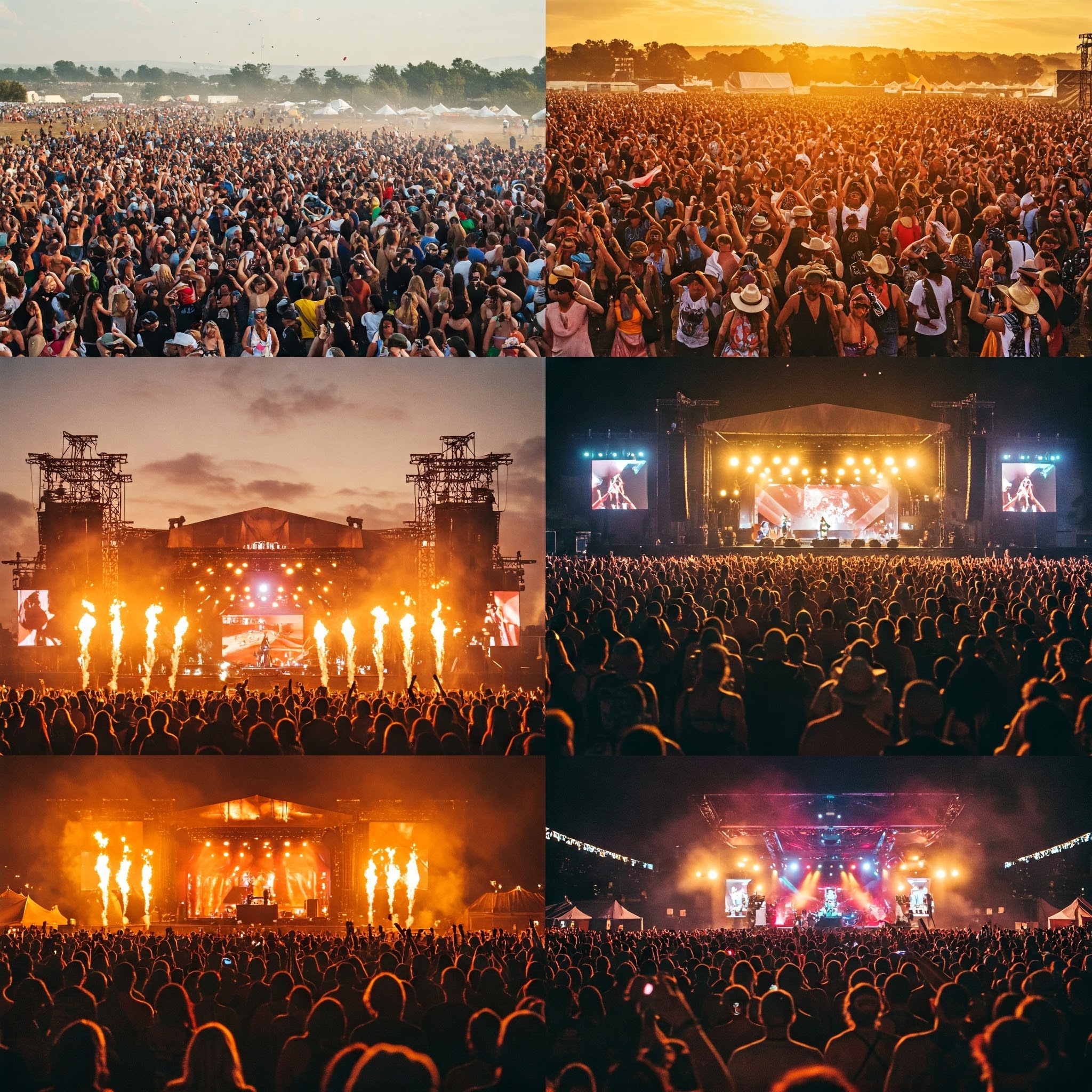When you ask, what are some of the biggest music festivals in the world? It can be helpful to take an in-depth look at their respective attendance, revenue, and their overall impact both culturally and economically. Also, before you ask- yes, the header images for this article were created using AI.
While there certainly were other music festivals before, and there have been many after, perhaps one of the world’s most infamous music festivals is undoubtedly the August 15 to August 18, 1969, event known as Woodstock. Known for helping to define the evolution of popular music and the counter-cultural movement of the era, Woodstock was famously plagued by a multitude of issues, but it also helped to launch careers for popular artists such as Carlos Santana, Jimi Hendrix, Grateful Dead, Creedence Clearwater Revival, Joan Baez, The Who, Jefferson Airplane, and others. While Woodstock may have had its issues, the modern music festival still draws many inspirations from this iconic event.
However, these days, music festivals have evolved into a huge global business, constituting monumental cultural phenomena, attracting millions of fans worldwide to experience live musical performances from a multitude of different musical acts, including diverse art installations, and- in many cases- an unforgettable sense of community. Some of these gigantic events are not only major highlights for music lovers but also massive economic engines that generate staggering revenues, employ thousands of people, and impact entire cities.
In this article, we’ll explore 19 of the biggest music festivals across the globe that are known for being consistently atop the rankings of the largest festivals as of 2025. These rankings are not in order and they are not necessarily definitive, but this list is meant to touch on some of the largest music festivals going today. These events all compete against each other to boast record-breaking attendance, eye-popping revenue, and incredible cultural significance on a global scale. Get ready to dive into the world of electrifying music festivals that shape the landscape of live music in 2025 in beyond.
1. Tomorrowland (Belgium)
Attendance: 400,000+
Revenue: $75 million+
Genre: Electronic Dance Music (EDM)
One of the largest and most iconic electronic music festivals in the world, Tomorrowland takes place every summer in Boom, Belgium. With its stunning stage designs, dazzling light shows, and top-tier EDM acts, Tomorrowland consistently attracts a diverse crowd of music lovers. In 2022, the festival reached an impressive 400,000+ attendees over two weekends, cementing its status as the largest EDM festival globally. The revenue from ticket sales, sponsorships, and merchandise pushes this festival’s earnings into the $75 million range.
2. Coachella (USA)
Attendance: 250,000+ at peak (approximately 200,000 estimated in 2024)
Revenue: $120 million+
Genre: Rock, Pop, Hip-Hop, EDM
Located in Indio, California, Coachella Valley Music and Arts Festival is arguably the most influential music festival in the United States as it has become a hotbed not only for the biggest musical acts- but for the biggest celebrity following perhaps of all festivals. If you aren’t rubbing elbows with Kendall and Kylie Jenner, are you really doing it right? Understandably, with a famously wide-ranging lineup that spans genres from rock and pop to EDM and hip-hop, Coachella attracts an international audience and it seems to have grown by the year. While attendance for the 2024 Coachella event was lower than expected at a reported 200,000, the 2022 edition saw over 250,000 people attend the festival, and ticket sales alone generated about $120 million. Add sponsorship deals, brand partnerships, and merchandise, and Coachella’s total economic impact is even larger.
3. Donauinselfest (Austria)
Attendance: 3 million+
Revenue: $40 million+
Genre: Pop, Rock, EDM
The Donauinselfest (Danube Island Festival) in Vienna is one of the world’s largest free music festivals, drawing over 3 million people annually. Held on an island in the Danube River, this festival celebrates not only music but also a sense of community and multiculturalism. Despite being a free event, the festival generates substantial revenue through sponsorships and ancillary services, contributing around $40 million to the local economy.
4. Glastonbury (UK)
Attendance: 200,000+
Revenue: $75 million+
Genre: Rock, Alternative, EDM
The legendary Glastonbury Festival in Somerset, England, is renowned for its sprawling grounds, diverse performances, and rich history in the world of music. Glastonbury attracts 200,000+ attendees each year, including massive headliners such as Beyoncé, The Rolling Stones, and Radiohead. The festival generates around $75 million annually, with ticket sales, merchandise, and broadcasting deals contributing significantly to its revenue.
5. Lollapalooza (USA)
Attendance: 400,000+
Revenue: $70 million+
Genre: Rock, Metal, EDM, Hip-Hop
Originally founded by Perry Farrell in 1991, Lollapalooza has grown into one of the world’s most prominent multi-genre music festivals. The event, held annually in Chicago’s Grant Park, regularly attracts over 400,000 attendees, with thousands more tuning in online. In 2022, the festival grossed over $70 million, with significant earnings from ticket sales, sponsorships, and exclusive VIP packages.
6. Rock in Rio (Brazil)
Attendance: 700,000+
Revenue: $150 million+
Genre: Rock, Pop, EDM
Rock in Rio is one of the largest and most famous music festivals, with editions held in Brazil, Spain, and Portugal. Its Brazilian leg, held in Rio de Janeiro, draws up to 700,000 people over a few days, making it one of the world’s most attended festivals. With its massive audience, brand partnerships, and sponsorships, Rock in Rio generates over $150 million in revenue. Past performers include giants like Queen, Lady Gaga, and Guns N’ Roses.
7. Ultra Music Festival (USA)
Attendance: 165,000+
Revenue: $50 million+
Genre: EDM
Held annually in Miami, Ultra Music Festival is one of the premier electronic dance music events globally. With an impressive estimated 165,000+ attendees at its 2024 edition, the festival continues to draw top-tier DJs and producers, making it a global hotspot for EDM fans. The event generates an estimated $50 million in revenue, with significant contributions from ticket sales, merchandise, and streaming rights.
8. Primavera Sound (Spain)
Attendance: 250,000+
Revenue: $45 million+
Genre: Indie Rock, Electronic, Hip-Hop
Held in Barcelona, Primavera Sound is a celebration of alternative and indie music, attracting over 250,000 attendees annually. Known for its eclectic lineups and international appeal, Primavera Sound has grown in stature over the years. With a wide variety of ticket options, sponsorships, and a strong brand presence, the festival generates upwards of $45 million in revenue.
9. Electric Daisy Carnival (USA)
Attendance: 400,000+
Revenue: $150 million+
Genre: EDM
The Electric Daisy Carnival (EDC) is a must-visit festival for EDM lovers, taking place in Las Vegas. EDC attracts a staggering 400,000+ attendees across multiple days of electrifying performances. For the duration of EDM, most Las Vegas Resort Casinos are completely booked with revelers descending on EDC. With its massive stage designs, high-energy performances, and carnival-like atmosphere, the festival generates $150 million+ in revenue from ticket sales, merchandise, and partnerships.
10. Sziget Festival (Hungary)
Attendance: 500,000+
Revenue: $70 million+
Genre: Rock, Pop, EDM
Held annually in Budapest, Sziget Festival is a multi-genre event that has grown into one of Europe’s largest music festivals. Drawing over 500,000 visitors annually, Sziget showcases acts across rock, pop, and EDM. With its immense crowd and global reputation, the festival generates an estimated $70 million in revenue each year.
11. Reading and Leeds Festivals (UK)
Attendance: 200,000+
Revenue: $55 million+
Genre: Rock, Alternative, Indie
The Reading and Leeds Festivals are two separate events held simultaneously in Reading and Leeds, UK. Together, they attract more than 200,000 people annually, featuring top-tier bands and artists from the alternative and indie rock scene. These festivals generate $55 million in revenue through ticket sales, sponsorships, and merchandising.
12. Newport Folk Festival (USA)
Attendance: 30,000+
Revenue: $10 million+
Genre: Folk, Americana, Indie
The Newport Folk Festival is a legendary American event, known for its roots music and Americana performances. Held in Newport, Rhode Island, the festival attracts around 30,000 attendees each year. Despite its smaller scale compared to other festivals on this list, its cultural significance is immense, with performances by Bob Dylan, Joan Baez, and countless others. It generates $10 million in revenue, making a major economic impact on the local community.
13. V Festival (UK)
Attendance: 175,000+
Revenue: $50 million+
Genre: Pop, Rock, EDM
V Festival, which took place in both Chelmsford and Staffordshire in the UK, attracted 175,000+ people annually before it ended in 2017. It was known for featuring mainstream pop and rock artists and was one of the UK’s most successful festivals, generating around $50 million in annual revenue.
14. Bonnaroo Music and Arts Festival (USA)
Attendance: 80,000+
Revenue: $20 million+
Genre: Rock, Indie, EDM
Held in Manchester, Tennessee, the Bonnaroo Festival is a beloved event that brings over 80,000 music fans together each year. Known for its diverse lineup that spans rock, indie, and EDM, Bonnaroo generates approximately $20 million in revenue, with ticket sales and sponsorships contributing heavily to the festival’s earnings.
15. Fuji Rock Festival (Japan)
Attendance: 100,000+
Revenue: $25 million+
Genre: Rock, Electronic, Jazz
The Fuji Rock Festival, held annually at the base of Mount Fuji, is Japan’s premier music event. The festival’s 100,000+ attendees enjoy a variety of music genres, ranging from rock and electronic to jazz. Its serene location and eclectic lineup make it a must-attend for many, with estimated revenues reaching $25 million.
16. Paléo Festival (Switzerland)
Attendance: 230,000+
Revenue: $40 million+
Genre: Rock, Pop, World Music
Held in Nyon, Switzerland, the Paléo Festival is one of Europe’s largest open-air festivals, drawing 230,000+ visitors each year. The festival’s mix of genres—rock, pop, and world music—ensures a broad demographic. Revenue generation comes in the form of ticket sales, sponsorships, and on-site spending, totalling approximately $40 million annually.
17. Mysteryland (Netherlands)
Attendance: 100,000+
Revenue: $25 million+
Genre: EDM
Held annually in Haarlemmermeer, Mysteryland is one of Europe’s top EDM festivals, drawing 100,000+ fans. With its cutting-edge stage designs and massive performances, the festival generates an estimated $25 million in revenue from ticket sales and sponsorships.
18. Austin City Limits (USA)
Attendance: 450,000+
Revenue: $60 million+
Genre: Rock, Country, Indie, Electronic
Austin City Limits is one of the premier festivals in the US, attracting 450,000+ fans every year. Known for its diverse lineup and its connection to the city’s rich musical heritage, the festival generates $60 million in revenue annually. In many ways, one could argue that ACL (as the locals call it) has helped contribute to the rising population and popularity of Austin, Texas, altogether.
19. MTV World Stage (Various Locations)
Attendance: 50,000+ per event
Revenue: $20 million+
Genre: Pop, Rock, Hip-Hop
MTV World Stage is a series of concerts that take place in various countries across the globe. While the individual attendance varies by location, the series collectively draws a total of over 50,000 people each year, generating about $20 million through ticket sales, broadcasting rights, and sponsorships.
There are many other massive festivals, like Burning Man and Rolling Loud, that could also have made this list. Regardless, as you can see, from the massive crowds at Tomorrowland for example, to the indie vibes of Newport Folk Festival, these music festivals showcase the diversity and richness of the global music scene. In many ways, it is proven once again that music fans love to congregate to share the experiences of concerts in many different atmospheres. Not only do most of these festivals certainly strives to provide world-class entertainment, but they also contribute significantly to local economies, attracting millions of attendees and generating billions of dollars in revenue worldwide.
These festivals represent the pinnacle of live music for many artists and music aficionados alike, combining in mays to offer fans unforgettable experiences while driving major economic impacts across the globe. Whether you’re looking for electronic beats, indie rock, rap, country, or any other sort of legendary performances, these events will most likely continue to shape the landscape of live music for years to come.



Thank you for your sharing this information. I am worried that the world may lack creative ideas with AI. It is your article that makes me full of hope that creativity is still alive and well. Thank you.